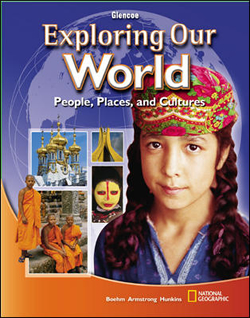Exploring Our World: People, Places, and CulturesChapter 23:
History and Cultures of South AsiaWeb Activity Lesson PlansIntroduction
In this chapter, students learned that geography impacts the development and the destruction of civilizations. The people who live in the Indus River valley are an example of a population continually working to adapt to their environment. Students will work on a Web site that focuses on the Indus River valley civilization. Lesson Description
Students will visit a geographic Web site. On this Web site, they will read an article about the Indus River valley and its civilization. They will then answer questions on the impact of the Indus River on the civilizations that have developed there. Instructional Objectives
- The learner will be able to discuss aspects of the ancient Indus Valley civilization such as farming, trade, and technology.
- The learner will be able to discuss the geography and the environment and their impact on the Indus Valley civilization.
- The learner will be able to understand that the same environment still supports the majority of the population of Pakistan.
Student Web Activity Answers - irrigation
- Mohenjo Daro: the lower part of the Indus River; Harappa: on the Ravi River, near the upper end of the Indus Valley.
- grid patterns for streets, common housing, sanitation, bathrooms/sewers; same elements are used in modern city building
- The Indus River empties into the Arabian Sea; the ships would then travel along the coastline of the Arabian Sea to get to Mesopotamia for trade.
- Seasonal flooding could help the fields but destroy the cities. Floods may have destroyed the city of Harappa.
- along the Indus River
 | 




